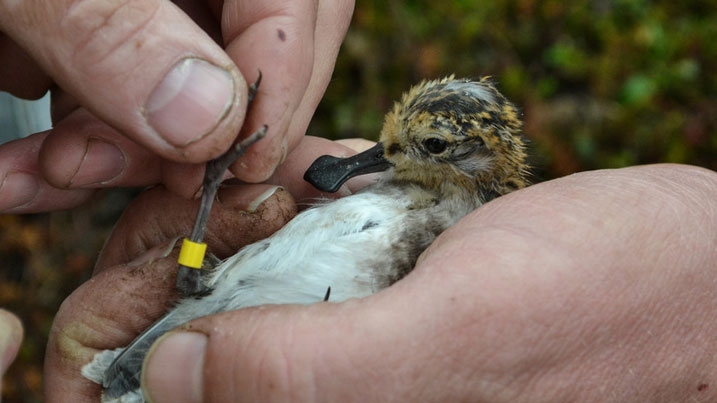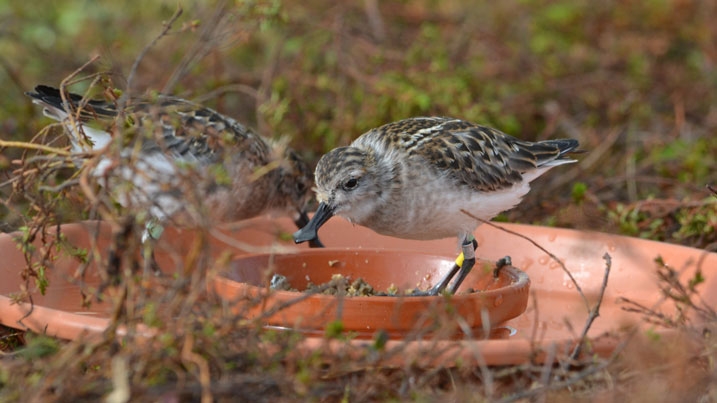Spoon-billed sandpiper update
Autumn 2024
In line with our strategy, we’re focusing on restoring habitats along the spoon-billed sandpiper’s flyways and migration landing sites, which we believe will bring lasting benefits to this species and many others. While this marks a shift from our previous species-specific efforts, it’s just as crucial for the long-term survival of the spoonies. With your continued support, we can work together to create a healthier, more sustainable future for these incredible birds.
Positive progress amidst challenges
The ongoing Russia-Ukraine conflict has continued its pause on spoonie headstarting work at the birds’ last known breeding grounds, but our historical partners, Birds Russia, have managed to continue expeditions to the site this year.
These expeditions have enabled important monitoring of the birds as well as marking them with coloured leg-rings so they can be tracked throughout their breeding, migrating and wintering locations. Monitoring is a key part of the project because it offers critical insights into how much time is left to save the species from extinction, as well as helping identify challenges in their various habitats and where we need to focus conservation efforts.

The spoonies’ breeding grounds are on the coastal tundra in northeastern Russia. Arriving there in late May and June, they court and display and make their shallow nests on the ground among crowberry plants and lichen. During this season, the spoonies feed mainly on insects including mosquitoes, flies, midges and beetles, foraging along the snowline, on the lakeside shores, and the surrounding tundra landscape.
When the chicks hatch, they begin feeding themselves within a day, watched over by the male parent while the female heads south for the winter. The male departs once the chicks have fully fledged, and the young spoonies migrate south joining flocks of other migrating waders some weeks later. On migration, adults and young alike depend on a variety of marine invertebrates such as shrimp and bristle worms.
With your sponsorship, you’re helping ensure more of these critically endangered birds can breed, feed and thrive into the future.
Laying the groundwork for future headstarting
While headstarting activity is necessarily paused, the team has begun preparing for a potential return to full operations, hopefully in 2025.
In summer, some of the headstarting team from conservation organisation, Birds Russia, joined an expedition to the breeding grounds to test and check the equipment used to incubate and rear the spoonies, in preparation for a restart.

Meanwhile, WWTs Conservation Veterinary Officer took the opportunity to develop a Health Risk Assessment, specifically for spoonie headstarting. Building on research and experience from the project so far, this comprehensive document identifies health risks and strategies to mitigate against them, as well as proposing response plans to ensure safe and successful future headstarting.
The road to resuming headstarting is not without its challenges, but it remains a key objective in the action plan to save the species. This project will help to reduce the rate of decline whilst the causes affecting spoonies’ survival in the wild continue to be tackled.
Conservation breeding: a legacy of knowledge
The first population of captive spoonies was established at WWT Slimbridge between 2011 and 2012, and the Conservation Breeding Project concluded ten years later, leaving behind a decade’s worth of invaluable experience and data.

This knowledge is now being collected and compiled so it can inform future conservation breeding efforts. The insights gained over these remarkable years will serve as a foundation for housing and breeding spoonies in captivity, as a final defence against total extinction of the species and hopefully bolster the wild population. Establishing a self-sustaining captive spoonie population remains key objective in the action plan.
Two male spoonies are still in residence at Slimbridge, and their ongoing care continues to provide insights that will keep shaping and progressing future conservation strategies.
Vital habitat restoration and capacity building
When the spoonies leave their northeast Russia breeding grounds, their migration journeys take them south to wintering sites along the coasts of East Asia, notably those of China and Korea. With much of this intertidal habitat historically lost to land claim, in line with our new organisational strategy our goal is to restore key areas to give the spoonies safe areas to migrate through and wintering grounds to feed.

Our Wetland Conservation Unit comprises a vastly experienced 60-strong team working to solve conservation problems nationally and internationally. As part of the teams’ East Asian Intertidal Wetlands Hotspot Initiative, we are focusing on restoring the intertidal habitat in this remarkable expanse of mudflat and shallow marine water, on which the spoonies rely.
These coastal areas are in high demand from the people who depend on them also, and so constitute features such as rice paddies, salt pans and aquaculture ponds often from land claimed from the sea. Advances in farming techniques have degraded or removed the tidal functions in these areas, to the detriment of nature, and added pressures on the endangered spoon-billed sandpiper.
By restoring tidal functions to these areas, we aim to create sustainable environments that support spoonies as well as the wider ecosystem in all its complexity. WWT Steart is a successful demonstration of best practice in intertidal restoration, one our staff now showcase to international audiences.
Our international training efforts are already making a lasting impact for spoonies. Last year, we co-delivered a course in Korea attended by decision-makers, site managers and senior government staff who oversee restoration work. This collaboration and training will enhance the success of the upcoming intertidal restoration projects and help ensure that conservation efforts are both effective and sustainable.
The SBS Action Plan: looking to the future
The updated international Spoon-billed Sandpiper Action Plan remains as guidance for saving this adorable bird, still perilously close to extinction.
The Action Plan calls for further research, habitat restoration, improved management of the critically endangered key wintering and migration sites and better protection from human disturbances. Together, thanks to your support, these actions will help ensure that the spoonie has a fighting chance of survival across its range, from northern Russia to Southeast Asia.

Kind support like yours means the spoon-billed sandpiper still has hope for a brighter, sustainable future. We remain committed to safeguarding this extraordinary species and the ecosystems where it should be flourishing.